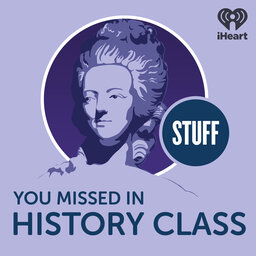The Gallaudet 11
The Gallaudet 11 were a group of Deaf men who were subjects in NASA’s research into the human body in the early years of the space program.
The transcript for this episode is here: https://bit.ly/3KnAGhA
Research:
- Bergey, Jean Lindquist. “Deaf Perspective: Inside View of Early Space Research.” Quest: The History of Spaceflight Quarterly. Vol. 25. No. 1. 2018.
- Bergey, Jean Lindquist. “How Being Deaf Made the Difference in Space Research.” Smithsonian Air and Space Museum. 4/7/2017. https://airandspace.si.edu/stories/editorial/how-being-deaf-made-difference-space-research
- Calandrelli, Emily. “In the 1960's 11 deaf men helped NASA get to the moon.” Twitter thread. 12/12/2019. https://twitter.com/thespacegal/status/1205258285412020225?lang=en
- Williams, Damien P., Heavenly Bodies: Why It Matters That Cyborgs Have Always Been About Disability, Mental Health, and Marginalization (June 8, 2019). Available at SSRN: https://ssrn.com/abstract=3401342 or http://dx.doi.org/10.2139/ssrn.3401342
- Clark, Brant and Ashton Graybiel. “Human Performance During Adaptation to Stress in the Pensacola Slow Rotation Room.” Aerospace Medicine. Vol. 32, No. 2, February 1961.
- Colehour, James K. and Ashton Graybiel. “Excretion of 17-Hydroxycorticosteroids, Catechol Amines, and Uropepsin in the Urine of Normal Persons and Deaf Subjects with Bilateral Vestibular Defects Following Acrobatic Flight Stress.” United States Naval School of Aviation Medicine and National Aeronautics and Space Administration. May 10, 1963.
- Crowell, Rachel. “Disabled Astronauts Blaze New Space Trails.” Scientific American. 10/20/2021. https://www.scientificamerican.com/article/disabled-astronauts-blaze-new-space-trails/
- David, Leonard. “Equal access to space: New study investigates how to get more 'parastronauts' aloft.” Space.com. 12/31/2021. https://www.space.com/inclusive-human-spaceflight-parastronaut-study
- Dowd, Jim. “9 Deaf Men Volunteer for Navy Research.” Pensacola News Journal. 12/28/1962.
- Eveleth, Rose. “It’s Time to Rethink Who’s Best Suited for Space Travel.” Wired. 1/27/2019. https://www.wired.com/story/its-time-to-rethink-whos-best-suited-for-space-travel/
- Fregly, Alfred and Robert S. Kennedy. “Comparative Effects of Prolonged Rotation at 10 RPM on Postural Equilibrium in Vestibular Normal and Vestibular Defective Human Subjects.” Bureau of Medicine and Surgery. March 23, 1965.
- Gallaudet University. “Deaf Difference + Space Survival Exhibition Video.” https://www.gallaudet.edu/museum/ddss-doc/
- Gohd, Chelsea. “Disability ambassadors successfully complete Zero-G flight.” Space.com. 10/19/2021. https://www.space.com/astroaccess-disability-ambassadors-zero-g-flight
- Harrington, Tracy. “Three Deaf Men Serve as Human Guinea Pigs.” Pensacola News Journal. 7/11/1962.
- Hotovy, Hannah. “How 11 Deaf Men Helped Shape NASA's Human Spaceflight Program.” NASA. 5/4/2017. https://www.nasa.gov/feature/how-11-deaf-men-helped-shape-nasas-human-spaceflight-program
- Irwin, J.A. et al. “The Pathology of Sea-sickness.” The Lancet. 11/26/1881.
- James, William. “The Sense of Dizziness in Deaf-mutes.” American Annals of the Deaf and Dumb , APRIL, 1883, Vol. 28, No. 2. Via JSTOR. https://www.jstor.org/stable/44460811
- Kellogg, Robert S. et al. “Motion Sickness Symptomatology of Labyrinthine Defective and Normal Subjects During Zero Gravity Maneuvers.” Technical Documentary Report AMRL-TDR-64-47. Air Force Systems Command. June 1964.
- Kennedy, Robert S. et al. “Symptomology Under Storm Conditions in the North Atlantic in Control Subjects and Persons with Bilateral Labyrinthine Defects.” United States Naval School of Aviation Medicine and National Aeronautics and Space Administration. May 1965.
- Larimer, Sarah. “‘I wanted to serve’: These deaf men helped NASA understand motion sickness in space.” Washington Post. 5/5/2017. https://www.washingtonpost.com/news/retropolis/wp/2017/05/05/i-wanted-to-serve-these-deaf-men-helped-nasa-understand-motion-sickness-in-space/
- NASA Video. “How Deaf and Hearing Impaired People Helped the Space Program.” Via YouTube. 5/11/2013. https://www.youtube.com/watch?v=zM47-nz24i4
- Space Center Houston. “Gallaudet 11 – Deaf Right Stuff.” 2/18/2020. https://www.facebook.com/watch/?v=3102869376605071
- U.S. Naval School of Aviation Medicine Pensacola, Fla. “Symposium on the Role of Vestibular Organs in the Exploration of Space.” Ashton Graybiel, General Chairman. Jan. 20-22 , 1965.
 Stuff You Missed in History Class
Stuff You Missed in History Class


